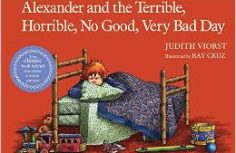THIRD READING: ANALYSIS – Alexander and the Terrible, Horrible, No Good, Very Bad Day
During this reading, your child and you have prior knowledge of how the text and picture fit together. Now, your interaction with the story will move to a higher level of thinking. The activities and questions below are considered “higher order thinking.” Activities and questions like these give the brain practice in being open to new ideas and creative thinking habits. Open-ended questions strengthen the brain by building new synapses.
For this reading you have the choice of how you read the story:
~reversing roles. Your child tells/”reads” the story, and you become the listener and questioner.
~ alternating the reading of pages with your child.
~pausing to allow your listener to fill in the next word or complete the sentence.
~jointly read: “….terrible, horrible, no good, very bad day” together.
DISCUSSION QUESTIONS:
~Could this story really happen?
~In what sequence did the terrible, horrible, no good very bad events happen to Alexander? (from waking up to bedtime) If the story continued, predict what would happen next?
~Why did Judith Viorst write a story about a terrible, horrible, no good, very bad day? Is there a lesson we can learn from the story?
~Did Alexander behave appropriately? Is there any time in the story when he could have behaved differently? Would this have helped to make the day better? Did he make good choices?
~What did Alexander’s mother say to help him solve his problem? Could she have said something that would have helped him to solve his problem?
~Does Alexander remind you of anyone? How are Alexander and you alike and different?
ACTIVITIES:
~Let’s predict that Alexander wakes up the next morning to the start of a great day! Write a story about his great day. What would the title of your story be? Make it similar to the title of the book with four descriptors for a wonderful day when everything goes well.
~You can also write a story about a terrible, horrible, no good, very bad day in your life. How would your day go badly from the time you wake up until the time you fall asleep?
Read more...
